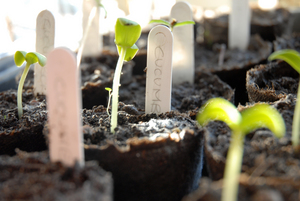Growing a vegetable garden can be a delight, especially for the urban gardener. It’s a fun and nutritious hobby, but getting started can become bewildering, especially if you live in an urban environment. You need to know how to plan out your garden for maximum benefits. One way to do this is to plan for a rooftop garden.
Planning your vegetable garden requires understanding your needs, your growing season and your space. Most urban gardeners can benefit from growing a garden using the square foot garden method. Using this method allows you to plant more vegetables in a smaller space than a conventional garden.
What are Square Foot Gardens?
Square foot gardens are typically arranged in 4 foot by 4 foot squares. Each 4 foot square is subdivided equally into 16 square feet. In each one foot square, you will need to plan a crop. Since plants are spaced close together, you can have a larger yield in a smaller space. For example, small crops such as radishes and carrots can be planted 16 seeds to a one foot square. Bush beans and onions grow at 9 plants per one foot square. Larger plants, such as lettuce, require 4 plants per square. Big plants like tomatoes and peppers take 1 plant per square.
Considerations for the Rooftop
Plan on using containers to grow your garden. If you’re handy (or have friends who are handy), you can construct a 4 foot by 4 foot garden box (or even several 2 foot by 4 foot boxes) to plant your vegetables in. Use special potting soil made for containers as this will be lighter and will hold more water than conventional topsoil. It will also drain appropriately. Be sure to add drain holes to keep your plants from drowning.
One bonus to having a rooftop vegetable garden is that it doesn’t have to be directly on the roof. There’s no reason you can’t elevate the boxes to waist height, thus making it easier to work on and will help save your back.
Types of Vegetables to Grow
Beginning gardeners will have their best luck with crops such as beets, corn, beans, cucumbers, tomatoes, Swiss chard, radishes, squash and lettuce. However, one consideration is how much you’re willing to eat. It doesn’t matter if radishes grow well, if you don’t like eating them. Choose vegetables that you like and you’re willing to eat.
Growing Season
Plan your garden according to the growing season. Many plants aren’t hardy and shouldn’t be planted until after the last frost. Some plants, such as beets and carrots, can be started weeks before the last frost. Depending on your geography, you will have to plan your summer crops with seeds developed for your growing region. For example, if you live in northern states where winter comes early, you’ll want to plant seeds for shorter growing periods.
When you harvest your vegetables from one square, you’ll be able to turn the soil over and plant more of another vegetable, thus making the garden do more with less space.
Size
Plan on one 4 by 4 garden per person in the household. If you wish more food or for freezing and canning, plant an extra 4 by 4 garden of plants.
Large climbing plants need trellis or grow stakes in order to grow upward, so plan on plants in the back of each 4 by 4 garden. Put smaller plants in the front and vine plants in the back.




